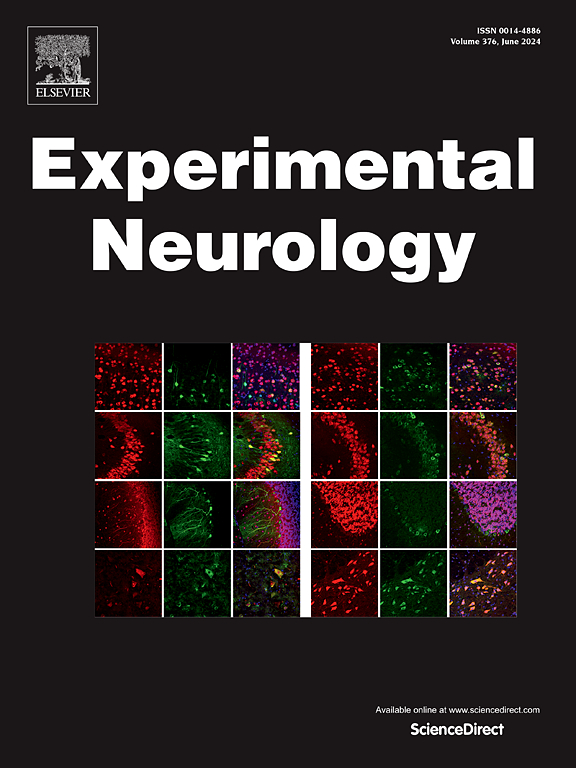Novel peptidomimetic compounds attenuate hypoxic-ischemic brain injury in neonatal rats
IF 4.6
2区 医学
Q1 NEUROSCIENCES
引用次数: 0
Abstract
Hypoxic-ischemic (HI) brain injury is a common neurological problem in neonates. The postsynaptic density protein-95 (PSD-95) is an excitatory synaptic scaffolding protein that regulates synaptic function, and represents a potential therapeutic target to attenuate HI brain injury. Syn3 and d-Syn3 are novel high affinity cyclic peptides that bind the PDZ3 domain of PSD-95. We investigated the neuroprotective efficacy of Syn3 and d-Syn3 after exposure to HI in neonatal rodents. Postnatal (P) day-7 rats were treated with Syn3 and d-Syn3 at zero, 24, and 48-h after carotid artery ligation and 90-min of 8 % oxygen. Hemispheric volume atrophy and Iba-1 positive microglia were quantified by cresyl violet and immunohistochemical staining. Treatment with Syn3 and d-Syn3 reduced tissue volume loss by 47.0 % and 41.0 % in the male plus female, and by 42.1 % and 65.0 % in the male groups, respectively. Syn3 reduced tissue loss by 52.3 % in females. D-Syn3 reduced Iba-1 positive microglia/DAPI ratios in the pooled group, males, and females. Syn3 effects were observed in the pooled group and females. Changes in Iba-1 positive microglia/DAPI cellular ratios correlated directly with reduced hemispheric volume loss, suggesting that Syn3 and d-Syn3 provide neuroprotection in part by their effects on Iba-1 positive microglia. The pathogenic cis phosphorylated Thr231 in Tau (cis P-tau) is a marker of neuronal injury. Cis P-tau was induced in cortical cells of the placebo-treated pooled group, males and females after HI, and reduced by treatment with d-Syn3. Therefore, treatment with these peptidomimetic agents exert neuroprotective effects after exposure of neonatal subjects to HI related brain injury.

新型拟肽化合物减轻新生大鼠缺氧缺血性脑损伤。
缺氧缺血性脑损伤是新生儿常见的神经系统疾病。突触后密度蛋白-95 (PSD-95)是一种调节突触功能的兴奋性突触支架蛋白,是减轻HI脑损伤的潜在治疗靶点。Syn3和d-Syn3是结合PSD-95的PDZ3结构域的新型高亲和力环肽。我们研究了新生儿暴露于HI后Syn3和d-Syn3的神经保护作用。在颈动脉结扎后0、24和48小时以及8 %氧气90分钟,给出生后第7天的大鼠注射Syn3和d-Syn3。甲酚紫染色和免疫组化染色定量检测半球体积萎缩和Iba-1阳性小胶质细胞。用Syn3和d-Syn3治疗,雄性和雌性的组织体积损失分别减少了47.0 %和41.0 %,雄性组分别减少了42.1 %和65.0 %。在雌性中,Syn3减少了52.3% %的组织损失。D-Syn3降低了混合组、男性和女性的Iba-1阳性小胶质细胞/DAPI比率。在合并组和雌性中观察到Syn3效应。Iba-1阳性小胶质细胞/DAPI细胞比例的变化与半球体积损失的减少直接相关,表明Syn3和d-Syn3部分通过其对Iba-1阳性小胶质细胞的作用提供神经保护。致病性顺式磷酸化的Tau蛋白Thr231(顺式P-tau)是神经元损伤的标志。HI后,顺式P-tau蛋白在安慰剂治疗组、男性和女性的皮质细胞中被诱导,并通过d-Syn3治疗而减少。因此,在新生儿暴露于HI相关脑损伤后,使用这些拟肽药物治疗可发挥神经保护作用。
本文章由计算机程序翻译,如有差异,请以英文原文为准。
求助全文
约1分钟内获得全文
求助全文
来源期刊

Experimental Neurology
医学-神经科学
CiteScore
10.10
自引率
3.80%
发文量
258
审稿时长
42 days
期刊介绍:
Experimental Neurology, a Journal of Neuroscience Research, publishes original research in neuroscience with a particular emphasis on novel findings in neural development, regeneration, plasticity and transplantation. The journal has focused on research concerning basic mechanisms underlying neurological disorders.
 求助内容:
求助内容: 应助结果提醒方式:
应助结果提醒方式:


